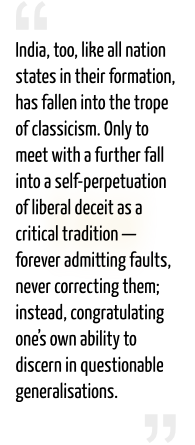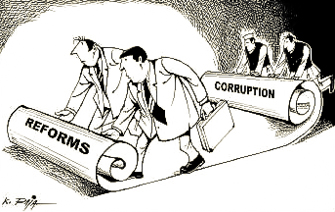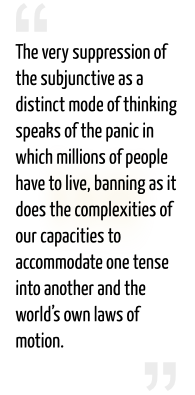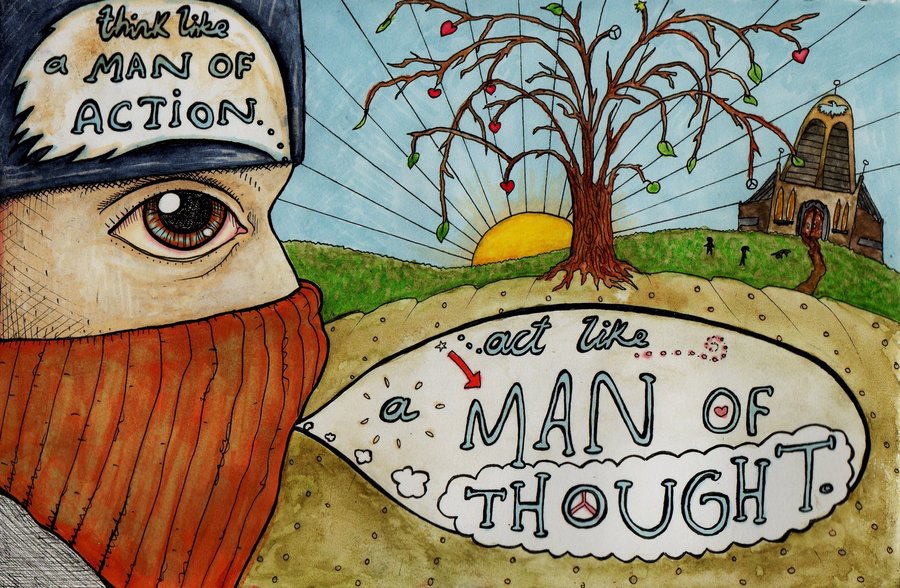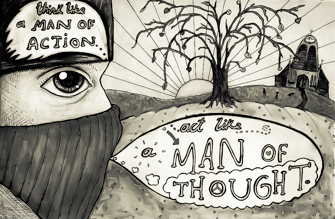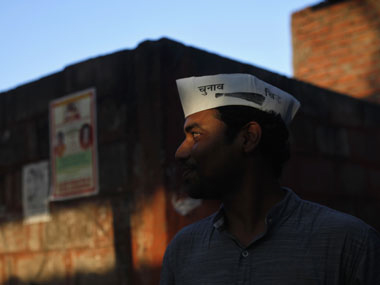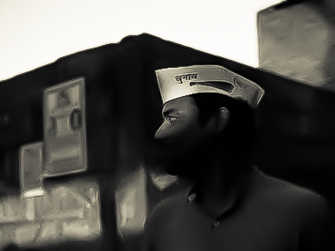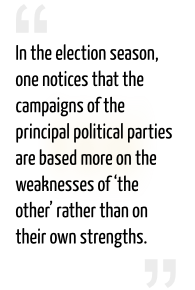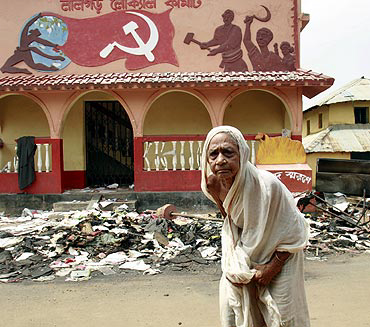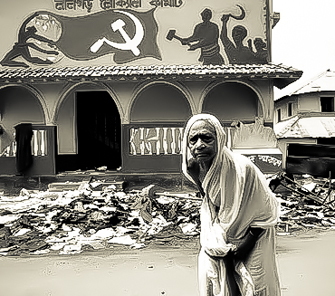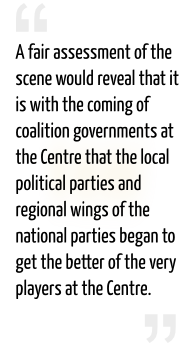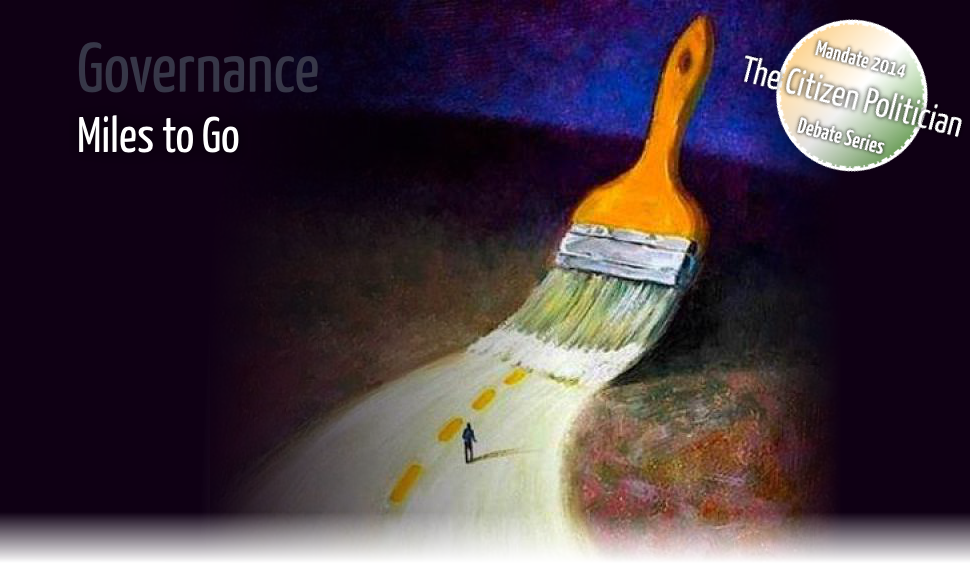
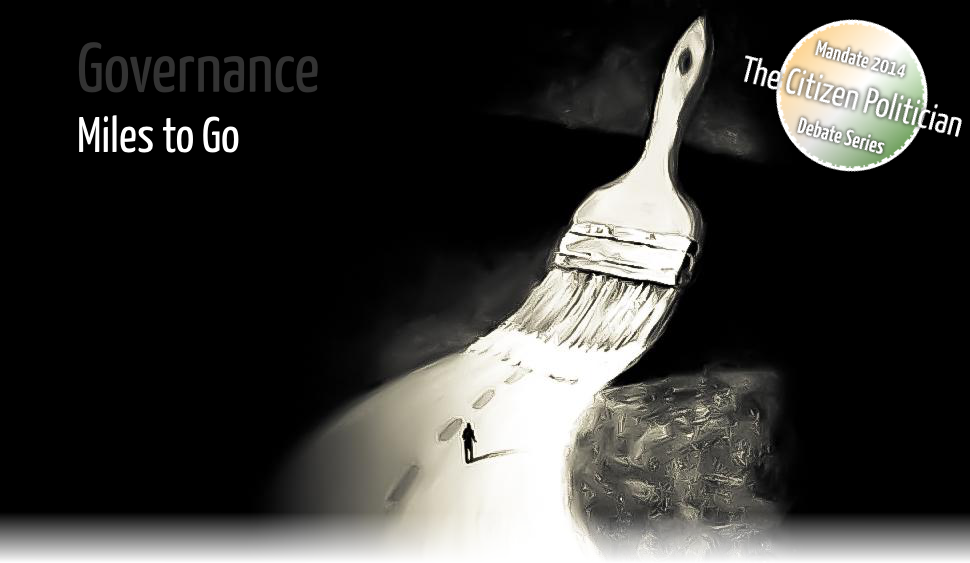
21 April 2014Reflecting on the art of thinking, Havelock Ellis observes that “in reality we only have succession and existence, and the ‘force’ is something we imagine.” The role of imagination in defining the power play among various processes of life must be treated with the gravity it deserves. In these techno-intensive times burdened by the deadweight of rationality, it is but hard to bring home to the citizens of such a fast-changing country as India, the crucial need to evaluate the imaginary of governance. Yet, such an evaluation alone will equip one to engage responsibly with one’s political context and arrive at a viable means of understanding and channelling power – one’s own as well as that of the State – towards action that transforms lives, thus shifting the equations in politics humanward. Such humanisation of politics is the primary responsibility of a Citizen Politician. In a lucid transpolitical exposition, filmmaker and philosopher Kumar Shahani discusses the possibility of evaluating the category of the imaginary. In her response, writer Rizio Yohannan Raj reflects on the ways to evaluate power in the political context of India. |
Hold the cursor on the illustrations to display animations and descriptions.
The Valuation of the ImaginaryKumar Shahani |
On Evaluating PowerRizio Yohannan Raj |
|
The Indian state is barely over half a century old, even though it seems to be struck with multiple sclerosis in every run-up to the General Elections. The relapses that affect our democratic functions seem to have a great deal to do with our being in a world that is constantly breaking news, reducing real time to a bought space hammered into false consciousness. Today, imaging technologies are abused to levels of prevarication hitherto unknown to ideologies, masquerading as prescriptions for the greatest good of the greatest number. The transition to ‘virtual reality as knowledge’ will soon be complete and the categorical Real will be for good or worse only in the imagination of subjectivities wired into software invented in boardrooms, redefining the Law as Menu of multi-tasking in which the contingent is predetermined. What is the scope, then, for an individual to intervene, to dream, to speak? And, what would be the nature of governance that makes freedom of dream and speech possible? To voice is to express the repressed, to bring forth a thought, an emotion, a truth — all that one can do in praxis, in science, in art and most importantly, through the daily chores. But, even that is being governed more and more by the dead capital of rationality embedded in our machines and computers. They have taken over the functions for the most part of our mental and physical endeavours. Earlier, our enterprises were energised by the particular imagination that could intervene in history and restore a governance responsible to all the people who form the nation, and not merely those who prop up the state — whether it be the indigenous local or the versatile floating global, both pretending to be the flaneur in love with his dark obscure objects of desire: “Insouciant and taciturn, Ganges…”; “even the colour black, seemed polished, bright, iridescent…”; “she shone like the calyx of a lotus.”
When we speak of India and its literature, its arts, its philosophical systems, we cannot but include, indeed rest upon, the great epics that have given us the ethical framework for praxis. Our sangeet has embodied in sound and gesture our universal knowledge. So too, colour and line — placed in the spectra of multiple infinites — have released energies as vibrant as life at its origins. But India, too, has, like all nation states in their formation, fallen into the trope of classicism. Only to meet with a further fall into a self-perpetuation of liberal deceit as a critical tradition — forever admitting faults, never correcting them; instead, congratulating one’s own ability to discern in questionable generalisations. This liberal agenda has the democratic intention of self-criticism, but it creates greater verbosity and little action. In turn, this inaction encourages a displacement of political reality, enabling a spurious moral tone to take over, indicting only the ‘corrupted’, not the ‘corrupter’, the powerful one who is in a position to corrupt. It changes for the worst even those who live for others in the purest compassion — for example, those in the service of the children starved of both material and spiritual comfort. Remember the slogans of the 20th century that spoke of purity against corruption, of race in one instance, of language in another, of nationality in yet another. In a desperate bid to overcome their poverty and deprivation, many fascisms were born in nations frustrated by the states of their own creation. Each of these nations imagined that the triumph of their will equates the annihilation of the most proximate, and perhaps vulnerable, races, languages and cultures. The wars that had preceded the 20th century were waged, after all, in the name of one god against another, one monism against another. Synoptically speaking, ‘The Law’ thus replaced nurture and compassion as the necessary means to overcome suffering engendered by the Leviathan. Thus grew the autonomous disciplines of language, mathematics, art and the institutions of power and money that also, through processes of institutionalisation, coerced and controlled creativity, unleashing a chain that annulled or ossified grammars, melodies, harmonics, imaginaries, unformed thoughts, energies as evanescent as perfumes. The globalised liberal world proclaims the end of one and the other as victories for one or the other, coercing the subjects to abdicate the languages of thought, to surrender creativity to the cell phone, other channels of communication and computer games where both desire and choice are predetermined by a set of rules designed by the hegemonic culture of the times. Today, our nation and our state have entered into a relationship of darkness and light where the autonomous extremes of morality and technology unite in their complementarity. We are witnessing such a simultaneity, an impoverisation of language which is also a significant tonality as it slips into resonances and overtones of a particular time and place, its acoustics that can make you levitate or sink into the bottom of the ocean, ‘to go beyond the senses’ into the ultra-not-yet and infra-to-be. The idea of purity, essence and origin is at every moment questionable and therefore, constantly replaceable by algebraic equivalences that transcend the given modulations. While liberally eschewing binaries and primitive dialectics, one needs to preserve complementarities and overtones. One may then access shifting coordinates that accommodate heightened discords and comforting shades of prohibited endearments. There is hence a need to bring forth new pulsating equilibria between the past and the present, giving experience and banal existence meanings — several meanings in the singular, the dual and the multiple — and the playful joy of the chance discovery. And wherever social organisation and technology collude to strip us of this joy, we have to weave another cloth as in the following poem, in just three lines:
With the play on tenses, the assonance in aate / aata / itihaas, and the pun in the word ‘shyam’, the lines, as if excerpted from everyday incompletion of speech, open up a kaleidoscopic spectacle of indirection. There is the flavour and taste of the consonant, vyanjana, here, that makes manifest the sign and its meaning by its very enunciation according to the mode of emotional resonances of rasa. It is a tragedy that modern interpretations tend to find in such enunciation only the flat, indicative targeted object or sound event. Indeed, in such simple forms exists the tensile and elastic container of the residual syllable, the wavelength of a colour or melodic note in movement, creating dimensions unknown till the moment of reception in an individual ear, with its million thin receptors that sensitise us to a cognition beyond ideologies, given parameters, manuals, -isms, prejudices of perception embedding themselves in cultures and nations. Each one of the above distortions creates a god, a technology, a singular and original, either preserving the vibrant health of its substance by adding yeast and bacteria or strictly banning leavened bread, yoghurt, pickle, to find its abode in the realm of the rotten, the corrupt, the historical known. Wasn’t ethics meant to be the aesthetics of the future!
But, when the future itself is being either pushed into corrupted images and ideals of the original past, or denied its very possibility of existence through formal devices, our thoughts are dampened by the acoustics of the present itself. For instance, the very suppression of the subjunctive as a distinct mode of thinking speaks of the panic in which millions of people have to live, banning as it does, the complexities of our capacities to accommodate one tense into another and the world’s own laws of motion. As the subjunctive mood denotes a mode of action or state as conceived but not as yet a fact, it can express a great variety of meanings — a wish, an enquiry, an exhortation or a hypothetical, conditional or prospective event. In the wake of the suppression of the subjunctive, we confront this question: how to include the future in the continuous present governed by compulsions of breaking news traceable to the globalisation of capital and the real-time mode, producing the impossibility of aligning action to thought and thought to action? Considering that all thought and action moving beyond the immediately impinging contingency are now pushed out into the realm of the derivatives embedded in computational disciplines, into the visual and auditory minus the tactile, olfactory and other ingestion, our sensation begins to arrest itself on the surface with a kind of unidirectional imperative operating at each and every second. Can we possibly act freely if our action does not align with our thought of action? Towards seeking an answer, we do need to reassess our very being in terms of real choices, not replaced by the illusion of our initiatives in meditating and selecting coffee from Coorg as against Colombia, or from the biblical lands. It is well known that all energies travel in different mysterious ways from one imaginary point to another — even from those that may not exist to those that just might — in the same way, as a thought, a life, an impulse, or an insight, does not exist at the time of its conception. So, within each sensuous form and its constituents, the synaesthetic capabilities can multiply tangential meanings, tenses, moods, declensions and conjugations. Such oblique significance is the substance of all écriture, wherein the senses can go beyond themselves, not only to create bizarre objects and other afflictions but also, more importantly, through the layering of multiple scales they can resignify, to restore and refresh in the child-like reverie of erotic adoration, the celebration of knowledge through actively composite forms. And, as much as we are instinctually empowered to search and find, we are fulfilled only by translating our thought into transformative action of oneself, simultaneously as we sense our sharing in the resplendence of Nature.
|
While the media is offering us more and more news editions and supplements, live telecasts and super primetimes, we tend to know lesser and lesser of what truly matters. At the end of the day, everything seems trivial due to the constant abuse of all space and time — script, image, sound, software, government, love. No content fulfils; no style stays. It is hard to engage with the politics of a world where movement is not vital and spontaneous, but merely undertaken due to some obsessive compulsive disorder, the origin of which no one knows or cares to find out. One sees no way to access one’s fundamental truth, freedom or belonging in such a scheme of shifts where, as Kumar Shahani rightly points out, virtual reality passes as knowledge. Contemporary politics is no longer about people’s actual thoughts, feelings and actions; it has come to be one with their mere projections. We read about Indian politicians buying facebook likes from Turkey, of a twitteratti coup upsetting a government, and of electronic channels mass-hypnotising electorates. Opinion polls are not about candid views of individuals, but about statistical lists, charts and graphs derived from complicated submission forms. Ours is a 3D democracy of closer-than-life images created by ready-to-abuse technologies for specific political boardrooms. Now, what use or relevance can any tone or bhava of freedom possibly have in a republic that has expelled all the real people? The question that Shahani asks is whether the real people still have a way of intervening in history to restore a governance of the people by the people and for the people. As this Inter-action forms the concluding part of a series of debates focussing on understanding the making of a citizen politician in our times, my own response here proposes to interpret Shahani’s text with special reference to India’s contemporary politics. The emergence of the Aam Aadmi Party in India has been one of the most significant political movements in the contemporary world, considering its insistence on the ethical framing of the practice of politics. Yes, the AAP has raised more questions in our minds than providing any specific answers to our long-standing problems concerning governance. Can the AAP consolidate the lessons from the exciting movements it is currently propelling and form a valid political ideology? Can its war against particular contexts and issues at hand sustain itself outside of the electoral mêlée and continuously contribute to the delivery of good governance? Outside these largely living-room concerns, every day of this fierce election season that violently manufactures muck and magnificence, inspiring and empowering truths are revealed too. What amazes one is how the AAP finds an everyday way to prove that real people are not altogether powerless when faced with what Shahani calls “the globalised liberal world [that] proclaims the end of one and the other as victories for one or the other” and “the dead capital of rationality embedded in our machines and computers.” The AAP movement has indeed pointed towards the urgent need to bring together the responsibility of every citizen to trust, support and nurture relevant political initiatives, and that of the politician to whet her action and ideology against her constantly evolving self and context. Whether the AAP and the people of India would succeed in effecting that mutuality, time alone can tell. But what we are presented with today is indeed a glorious opportunity to lay the foundation for a powerful political philosophy that profoundly connects with the sensuous challenge of ethical change that India presents to each one of us, and to develop an organic methodology to make possible a governance facilitating such transformation.
Shahani’s observation that many fascisms were born in nations frustrated by the states of their own creation, finds oracular resonances in some recent political developments in the country. In the election season, one notices that the campaigns of the principal political parties are based more on the weaknesses of ‘the other’ than on their own strengths. This is another kind of deceit masqueraded as critical tradition. It leads not only to verbosity and ineffectuality, but also to fascist self-indulgence and attachment to power. A case in point is the BJP’s enormous brand-building exercises highlighting prospective good governance. When seen against the country’s deprivation and want, this vulgar display of confidence forces us to ask if the party is desperately searching for its own core, and if our democracy is seriously threatened by a parasitic development paradigm whose consuming nature is essentially alien to the Indian reality of myriad simultaneities. The concerns raised here seem to be presenting themselves more intensely to the BJP than to the other parties, with the introduction of its newest product into the political marketplace: the individual-oriented campaign. Perhaps it deserves to be mentioned here that this sort of branding needs to be distinguished from the politics involving personalities, for, ‘personality’ is a figurative category of political leadership, and hence its use often has a subtle affect on the public. In contrast, the ‘individual’ is its own gross material presence, and it has no symbolic or uplifting value for the society. The ultimate challenge that the BJP faces today is whether it can churn itself and discover a secular democratic vitality for its sustenance in the enigmatically pluralistic Indian space. But, it seems, the true credit for the abnormal booming of the BJP’s Gujarat-model development must go to the Indian Left Front and the Congress party. They have both indulged in furious verbal parades to critique and mock at the rise of the three-pronged mantra, ‘skill-speed-scale’, which has long been used as the spine of the BJP’s development narrative. Ironically, neither the Left nor the Congress party has attempted to create an on-the-ground counter movement to expose the above text. The Indian Left Front has, in all appearance, lost sight of the fact that its strategy of negation has been rendered ineffectual by its stunted growth in the Indian political terrain. Unless the Left understands its own contextuality and launches a rigorous action phase, it would miserably fail in offering any resistance to the neoliberal advances that it is in principle opposed to, and would eventually lose its relevance in this country. Instead of indulging in futile verbal battles, why does not the Left expose the Gujarat model through a serious intellectual engagement that reveals the ruinous axis on which skills are being used, speed is being gained, and processes are being scaled up? It is high time the Left realized that neither verbal defence nor bloody revolution is the solution for the challenge the Indian democracy is facing in these techno-intensive times. In order to launch a creative movement along the true axis of democracy, it must prepare itself for a poignant interaction with history as well as show a greater willingness to keep pace with contemporaneity. The Left must now lead a movement involving rigorous study, cultural connect, and creative action on the right axis, largely involving the youth, women and the marginalised of this country. It has to reinvent its spirit of cultural activism and evolve a new imaginary for governance in order to connect with the world. The Indian National Congress is the saddest countenance of our democracy. Facing severe criticism for perpetuating bad governance and corruption for a decade on the one side, and, on the other, pitted against the media-boosted BJP campaign that at times, knowingly or unknowingly, slips into the Hindutva trail, the INC is nearly dead. Yet, to safeguard the secular interests of millions of Indians, this party must reorganise itself and evolve a governance methodology and public interface strategy pertinent to the sustenance of its core liberal ideology. Towards such reconfigurations, both the Left Front and the Congress party have to develop a state of the art political attitude… indeed! An interesting feature of contemporary Indian politics is that the original Centre holds hardly any control. There has been a shift of power to the peripheries in the case of all the political organisations discussed here. With most of the senior leaders sidelined or ousted, the BJP projects the Chief Minister of a state as its primeministerial candidate, and revolves an entire election campaign around his name. The senior national leadership of the Congress is rendered utterly ineffectual with stains of scams and corruption charges on them. The burden of redeeming this grand old party from its sins seems to be on the young shoulders of the Congress Vice President. But what is actually holding the fort for the Congress is the grit and stability of the leadership in faraway states like Assam and Kerala. And lastly, the Left has been reduced to a few regional pockets with the fall of Bengal.
The extensive deployment of this centrifugal trend in the country is further evidenced by the defining roles the regional forces — the Tamil and Telugu parties, the Hindutva strongholds in the western coast, the BJD in Odhisha, TMC in West Bengal, the UP and Bihar forces — now play in the formation of ruling coalitions at the Centre. A fair assessment of the scene would reveal that it is with the coming of coalition governments at the Centre that the local political parties and regional wings of the national parties began to get the better of the very players at the Centre. While the representation that the regional political actors gets in coalition governments is a sign of healthy democracy, self-centric operations of local players can ruin glorious opportunities to deliver strong governance. It becomes doubly devastating when national parties are taken over from within by actors with limited experience and narrow agendas. The risk embedded in this unprecedented shift of power to the peripheries is that it would result in the total loss of a political actor’s national perspective, political philosophy and ideological anchorage — regional politics in India being an altogether different game based on many limited considerations such as caste, creed, race, and even family. The national parties must gather themselves to introspect and conscientiously develop a translocal idiom and methodology for their internal administration. The lack of well-balanced thought and articulation at the governmental level could also lead to diplomatic blunders, thus jeopardising India’s international relations. Again, it is the AAP that is now making a counter movement in the spiral of power distribution in the country, transiting quickly from the scale of a state level movement to ensure its presence across the country. But one must remember that the AAP still has not gained the political maturity to engage with the entire country, or with other nations. Perhaps, it requires a nuanced understanding and experience of ‘shame as a revolutionary sentiment’ for each one of us to gather the creative power to fight the parochial structures of fascism. In these times, a citizen politician needs to continuously renew her will, demeanour and legacy in order to claim her truth, freedom and belongingness. And it is the power of that reclamation that would enable her, as Shahani suggests, “to bring forth new pulsating equilibria between the past and the present; giving experience and banal existence meanings — several meanings in the singular, the dual and the multiple — and the playful joy of the chance discovery.” And then shall she gain for herself and her fellow citizens the power to weave a new imaginary of governance that aligns our action as well as thought of action with the design of Nature, and to “reassess our very being in terms of real choices” “wherever social organisation and technology collude to strip us of this joy”. And, it is that happy lesson of remaking our selves that must give us further power to go on. |
|
Kumar Shahani is a noted Indian filmmaker who was largely responsible for the development of the ‘New Indian Cinema’. He was a pioneer of the ‘Indian New Wave’ that created an avant-garde cinema whose ideology was vastly different from the aesthetics of mainstream cinema prevalent till the seventies. His major films include Maya Darpan (1972), Tarang (1984), Khayal Gatha (1989) and Kasba (1991). He has also worked on a range of highly acclaimed short films.
|
Rizio Yohannan Raj is a bi-lingual writer and educationist. Her works include three collections of poetry in English: Eunuch (2010), Naked by the Sabarmati and Other Guna Poems (2012) and Exchanges with the Thinker (2013). She is also the author of two novels in Malayalam (Avinasom and Yatrikom), the first of which is translated into English as A Tale of Things Timeless (2012). Her academic works include a pioneering volume on Comparative Literature, Quest of a Discipline: New Academic Directions for Comparative Literature (2012). Rizio is the Executive Director of LILA.
|
Disclaimers: The opinions expressed by the writers are their own. They do not represent their institutions’ view.
LILA Inter-actions will not be responsible for the views presented.
The images and the videos used are only intended to provide multiple perspectives on the fields under discussion.
Images courtesy: Lectorium Rosicrucianum | NFSA | Harvard Political Review | That Background Guy | Sophie’s Tree | Reuters for First Post | Rediff
Share this debate… |
… follow LILA… |
||||



